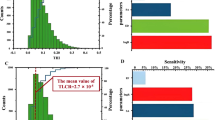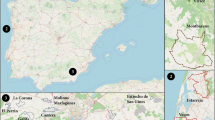Abstract
The burgeoning demands of China’s urbanization and industrial development put pressure on the resources of the entire country and have direct and indirect effects on the health of individuals, at times in areas far removed from cities themselves. Current evidence suggests that heavy metal pollution in soil, a common by-product of coal mining and other industrial activities, may be linked to risk of birth defects. We examine this hypothesis using small area level data including soil samples and detailed birth records from 2002 to 2004 from 97 villages in Shanxi province, a heavy coal-mining region. We find that soils containing arsenic, lead, and nickel are significantly correlated with the incidence of birth defects. In particular, we find a strong positive dose-dependent association of birth defects with lead, a moderate positive effect with arsenic, and a dose-dependent negative association with nickel. These results are consistent with the postulated link between arsenic and lead and human birth defects, but raise questions about the effects of nickel in this context. China’s rapid urbanization underscores the need for closer attention to the relationship between the health and the environment.


Similar content being viewed by others
References
Bates, M. N., Smith, A. H., & Cantor, P. K. (1995). Case-control study of bladder cancer and arsenic in drinking water. American Journal of Epidemiology, 141(6), 523–530.
Bates, M. N., Smith, A. H., & Hopenhayn-Rich, C. (1992). Arsenic ingestion and internal cancers: A review. American Journal of Epidemiology, 135(5), 462–476.
Besag, J., & Newell, J. (1991). The detection of clusters in rare diseases. Journal of the Royal Statistical Society. Series A (Statistics in Society), 154(1), 143–155.
Caldwell, B. K., Caldwell, J. C., Mitra, S. N., & Smith, W. (2003). Searching for an optimum solution to the Bangladesh arsenic crisis. Social Science and Medicine, 56, 2089–2096.
Chen, Y., & Zhang, K. (2005). The research development of the relation between birth defects and environment. Studies of Trace Elements and Health, 22(1), 52–54.
Chinese Birth Defect Monitoring Cooperation Group. (1992). Chinese birth defect map. Preface. China: Cheng Du Map Press.
Company, R., Serafim, A., Lopes, B., Cravo, A., Shepherd, T. J., Person, G., et al. (2008). Using biochemical and isotope geochemistry to understand the environmental and public health implications of lead pollution in the lower Guadiana River, Iberia: A freshwater bivalue study. Science of the Total Environment, 405, 109–119.
Fischer, A. B., Georgieva, R., Nikolova, V., Halkova, J., Bainova, A., Hristeva, V., et al. (2003). Health risk for children from lead and cadmium near a non-ferrous smelter in Bulgaria. International journal of Hygiene and Environmental Health, 206, 25–38.
Gang, B., & Zhuang, Z. (2000). The progress of toxicologically of nickel in China. Journal of Toxicology, 14(3), 129–135.
Geiser, K. (1993). Protecting reproductive health and the environment: Toxics use reduction. Environmental Health Perspectives, 101(Suppl 2), 221–225.
Gilboa, S. M., Mendola, P., Olshan, A. F., Harness, C., Loomis, D., Langlois, P. H., et al. (2006). Comparison of residential geocoding methods in population-based study of air quality and birth defects. Environmental Research, 101(2), 256–262.
Goujard, J. (1999). Clusters of birth defects: Emergency and management. A review of some publications. European Journal of Epidemiology, 15(9), 853–862.
Griffith, D., & Robert, H. (2006). Beyond mule kicks: The Poisson distribution in geographical analysis. Geographical Analysis, 38, 123–139.
Gu, X., Lin, L., Zheng, X., Zhang, T., Song, X., Wang, J., et al. (2007). High prevalence of NTD in Shanxi Province: A combined epidemiological approach. Birth Defects Research Part A-Clinical and Molecular Teratology, 79, 702–707.
Haining, R. (2003). Spatial data analysis: Theory and practice. Cambridge: Cambridge University Press.
Haining, R., Law, J., & Griffith, D. (2009). Modelling small area counts in the presence of overdispersion and spatial autocorrelation. Computational Statistics and Data Analysis, 53, 2923–2937.
Harper, C. C., Mathee, A., von Schirnding, Y., De Rosa, C. T., & Falk, H. (2003). The health impact of environmental pollutants: a special focus on lead exposure in South Africa. International Journal of Hygiene and Environmental Health, 206, 315–322.
He, Y., Zhang, K., Wang, J., Zheng, X., & Zhang, T. (2008). Analysis of element content in water in the high prevalence areas of Shanxi province. Maternal and Child Health Care of China, 23, 1246–1248.
International Clearinghouse for Birth defects (2008). http://www.icbdsr.org.
Jin, Y., Liao, Y., Lu, C., Li, G., Yu, F., Zhi, X., et al. (2006). Health effects in children aged 3–6 years induced by environmental lead exposure. Ecotoxicology and Environmental Safety, 63, 313–317.
Langlois, P. H. & Scheuerle, A. (2007). Using registry data to suggest which birth defects may be more susceptible to artifactual clusters and trends. 20th Annual Meeting of the Society for Pediatric and Perinatal Epidemiologic Research, Boston.
Li, Z., Ren, A., Zhang, L., Guo, Z., & Li, Z. (2006a). A population-based case-control study of risk factors for neural tube defects in four high-prevalence areas of Shanxi province, China. Paediatric and Perinatal Epidemiology, 20(1), 43–53.
Li, X., Wang, J., Liao, Y., Meng, B., & Zheng, X. (2006b). A geological analysis for the environmental cause of human birth defects based on GIS. Toxicological & Environmental Chemistry, 88(3), 551–559.
Li, P., Yang, H., & Li, Y. (2003). Study on the incidence distribution of birth defects and analysis on those suspected teratogenic factors in Lvliang area, Shanxi province. China J Fami Plan, 88, 90–94.
Liu, L. (2009). Urban environmental performance in China: A sustainability divide? Sustainable Development, 17(1), 1–18.
Longford, N. T. (1999). Multivariate shrinkage estimation of small area means and proportions. Journal of the Royal Statistical Society. Series A (Statistics in Society), 162(2), 227–245.
Ma, Y. (1998). Environment inspection. Wuhan: Wuhan Industry Unversity Press.
Ma, J., Zhu, J., Yu, F., Liu, Y., & Zhang, S. (2006). Biological impact of nickel pollution on pakchois in drab soil and its critical value. Journal of Ecology and Rural Environment, 22(1), 75–79.
McElroy, J. A., Remington, P. L., Trentham-Dietz, A., Robert, S. A., & Newcomb, P. A. (2003). Geocoding addresses from a large population-based study: Lessons learned. Epidemiology, 14(4), 399–407.
Michal, F., Grigor, K. M., Negrovilar, A., & Skakkebak, N. E. (1993). Impact of the environment on reproductive health: Executive summary. Environmental Health Perspectives, 101(Suppl 2), 159–167.
Milton, A. H., Smith, W., Bayzidur, R., Ziaul, H., Umme, K., Dear, K., et al. (2005). Chronic arsenic exposure and adverse pregnancy outcomes in Bangladesh. Epidemiology, 16(1), 82–86. doi:10.1097/1001.ede.0000147105.0000194041.e0000147106.
Oller, A. R., Costa, M., & Oberdörster, G. (1997). Carcinogenicity assessment of selected nickel compounds. Toxic Application Pharmacol, 143, 152–166.
Qi, Q., Yang, Y., Yao, X., Ding, L., Wang, W., Liu, Y., et al. (2002). The blood lead level among children living in urban regions of China. Chinese Journal of Epidemiology, 23(3), 15–18.
Saha, J. C., Dikshit, A. K., Bandyopadhyay, M., & Saha, K. C. (1999). A review of arsenic poisoning and its effects on human health. Critical Reviews in Environmental Science and Technology, 29(3), 281–313.
Shannon, M. (2003). Severe lead poisoning in pregnancy. Ambulatory Pediatrics, 3(1), 37–39.
Shi, C., Zhao, L., Guo, X., Gao, S., Yang, J., & Li, J. (1996). The distribution and effects of soil elements background value in Shanxi province, China. Agro-Environmental Protection, 15(1), 24–28.
Sun, X., Wei, C., & Wang, W. (2006). Progress in the study of arsenic species and bioavailability in soils–A review. Advances in Earth Science, 21(6), 625–632.
Tan, J. A. (2004). Geo-environment and health. Beijing: Chemical Industry Press.
Texas Department of State Health Services. (2004). Birth defects risk factor series. Austin: Texas Department of State Health Services.
US Department of Health & Human Services. (2005). Eleventh report on carcinogens. Washington: US Department of Health & Human Services.
Watanabe, G. (1977). Environmental determinants of birth defect prevalence. Teratology, 16(3), 367.
WHO. (1993). Evaluation of certain food additives and contaminants. Forty-First Report of the Joint FAO/WHO Expert Committee on Food Additives. Geneva: World Health Orgnization.
WHO. (1994). International statistical classification of diseases and related health problems (10th ed.). Geneva: WHO.
Wu, J. (2008). The harmonization of the national projection of human development’s main function regionalization and the relationship between population and environment development. Population and Development, 14(5), 43–45.
Wu, J., Wang, J., Meng, B., Chen, G., Pang, L., Song, X., et al. (2004). Exploratory spatial data analysis for the identification of risk factors to birth defects. BMC Public Health, 4(23), 1–10.
Zhang, D., Aunan, K., Martin, S. H., Karssen, S., Liu, J., & Zhang, D. (2010). The assessment of health damage caused by air pollution and its implication for policy making in Taiyuan, Shanxi, China. Energy Policy, 38(1), 491–502.
Zhang, K., Peng, W., & He, Y. (2007). Analysis on trace element of geochemical environment in high prevalence area of birth defects. Chinese Journal of Public Health, 23(1), 54–56.
Acknowledgments
This study was supported by the National Key Project (973) of Study on Interaction Mechanism of Environment and Genetic of Birth Defect in China (No. 2007CB5119001), State Key Funds of Social Science Project (Research on Disability Prevention Measurement in China, No. 09&ZD072, National Yang Zi Scholar Program, 211 and 985 projects of Peking University(No. 20020903).We are grateful to Landis MacKellar for his insightful comments. We would also like to thank Prof. Zhang Keli’s research group for its support with soil sample testing at the Environment Test Center of Beijing Normal University.
Author information
Authors and Affiliations
Corresponding author
Rights and permissions
About this article
Cite this article
Zheng, X., Pang, L., Wu, J. et al. Contents of heavy metals in arable soils and birth defect risks in Shanxi, China: a small area level geographic study. Popul Environ 33, 259–268 (2012). https://doi.org/10.1007/s11111-011-0138-0
Published:
Issue Date:
DOI: https://doi.org/10.1007/s11111-011-0138-0




